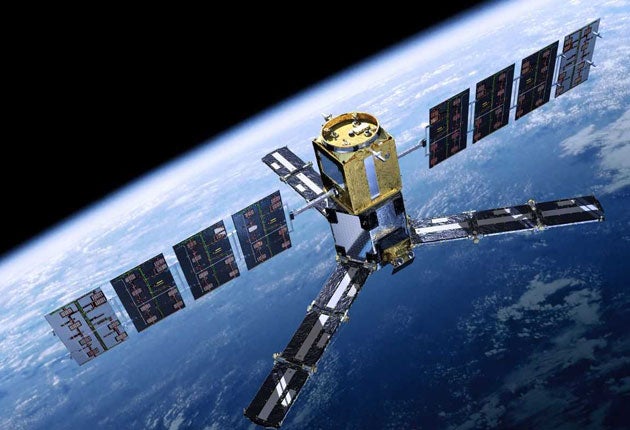Flood money: The water cycle
Plotting the world's water is expensive – a satellite designed for the job cost £280m. Holly Williams explains why its findings will be worth the investment

Your support helps us to tell the story
From reproductive rights to climate change to Big Tech, The Independent is on the ground when the story is developing. Whether it's investigating the financials of Elon Musk's pro-Trump PAC or producing our latest documentary, 'The A Word', which shines a light on the American women fighting for reproductive rights, we know how important it is to parse out the facts from the messaging.
At such a critical moment in US history, we need reporters on the ground. Your donation allows us to keep sending journalists to speak to both sides of the story.
The Independent is trusted by Americans across the entire political spectrum. And unlike many other quality news outlets, we choose not to lock Americans out of our reporting and analysis with paywalls. We believe quality journalism should be available to everyone, paid for by those who can afford it.
Your support makes all the difference.You've probably heard the dubious statistic that a glass of tap water in London has cycled through seven different people before ending up in your tumbler. But how much does water cycle naturally around the world? You might also remember those diagrams with lots of arrows in science lessons, showing water cycling between the seas, skies and rivers, but what is the relationship between the global water wheel and our environment?
When it comes to the amount of water that trickles, drips and sloshes over the surface of our planet, the numbers are almost too large to grasp. The total amount of water is 1.5 billion cubic kilometres – that's the equivalent of 651,041,667 Lake Windermeres. Most of this water is in the oceans (1.4 billion km3), and while plenty more is locked up in land ice, glaciers and land water, some 13,000 km3 is found in the atmosphere. Around 38,000km3 of water moves annually from the ocean to the land, with around the same amount returning down rivers to the seas. But about three times as much rain falls over the continents, meaning that a lot of water is recirculating just over land.
The movement of water varies around the world. The Pacific Ocean has quite a self-contained cycle, with little water movement towards land. The Atlantic and Indian oceans see more water cycling onto land: two thirds of water moving towards the continents comes from the Atlantic Ocean, with the final third from the Indian Ocean. The majority of water in Europe, the Americas and Africa comes from the Atlantic as rain – and returns to the ocean through rivers.
Getting statistics on this huge waterwheel can be a challenge – and an expensive one at that. Recently a satellite has been helping out scientists by providing new information on "Soil Moisture and Ocean Salinity" (Smos). Launched in November by CESBIO (centre for the study of the biosphere from Space), the £280m Smos spacecraft carries an interferometric radiometer that measures the emissions of natural microwaves from the earth's surface, allowing it to track changes in the dampness of soil and increases in saltiness on the seas' surface.
Looking a bit like a helicopter, with three extended arms housing 69 small antennae, Smos can deliver an image of everywhere on earth in just three days, providing more accurate weather forecasts, data on the thinning of ice in polar regions, and advance flood warnings.
One of the mission's scientists, Dr Matthias Drusch, told the BBC when Smos was launched in November: "If you see that your soils are already very wet and there is forecast for precipitation, you know there is a potential danger of flooding because the soils are already saturated."
As the way in which water moves is largely dictated by temperature – water warms and evaporates from the seas or cools and fall as rain – scientists are predicting that global warming may have serious impact. The increase in temperature could lead to more extreme distribution of precipitation – basically, wet areas will get wetter and dry area dryer, leading to an increased risk of flood and drought.
As our planet warms up, thanks to raised levels of greenhouse gasses such as carbon, we're likely to see increases in evaporation, leading to an increase in the amount of water vapour in the atmosphere. The amount of water falling as rain or snow is also going up, but noticeably slower than the increases in water vapour. The consequence of these uneven developments is likely to be a more extreme hydrological cycle – so places which already get a lot of rain will get much more.
So will this make holidays in Wales even soggier? Well, the largest increases in activity are predicted to occur at the most extreme ends of the water cycle. So more rain is likely to fall in the equatorial region where northern and southern hemisphere winds collide, and in middle and high altitude storm tracks, while mid-latitude areas – the Mediterranean, California and Texas, southern Africa and Australia – are likely to see less precipitation.
However, the impact of climate change on the water cycle may be felt globally, with potentially devastating results in the worst-affected areas, which is why this costly technology is worth its price tag. As Professor Lennart Bengtsson, the director of earth science at the International Space Science Institute, puts it: "The large increases in extreme precipitation suggested from models is likely to have serious consequences ... if such changes occur the consequences will be severe, requiring urgent enhancements of flood protection systems." Let's hope Smos provides more of those advance flood warnings too.
Join our commenting forum
Join thought-provoking conversations, follow other Independent readers and see their replies
0Comments